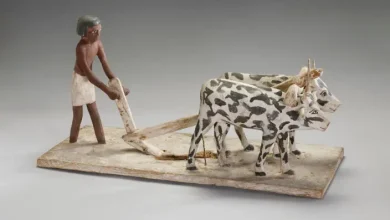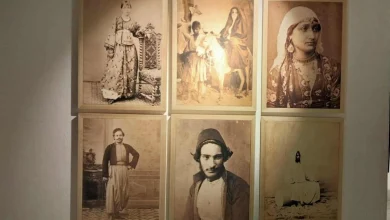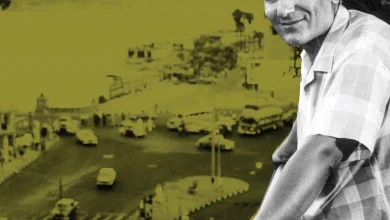
Cairo, July 15: What did Duha say about Cairo in the 1960s? (2-2)
In our analysis of Duha’s novel, told to Bahaa Taher, we concluded the last episode with a scene highlighting the contrasting parallel between the abandoned coffee shop and the bean sandwich shop in “Suleiman” Square, as the narrator chose to call it. As for the comparison of the crowd of customers in front of the bean shop to a demonstration, we see it as a meaningful analogy: it is not only about the large number of people, but also that the word “demonstration” here does not have a political or social connotation, but rather expresses a basic need: food. This is not surprising, given that the political stalemate in Egypt during the Nasser era allowed only this type of demonstration!
The choice of the radio song is also significant. “Al-Hawan wa Ya Akza” is an old song performed by Mohamed Abdel Wahab in 1932. The title refers to a lover who is suffering from abandonment but is content. It is as if the author, by choosing this song, wanted to reflect the situation of most Egyptians during the 1960s: they were suffering under the weight of economic crises and political turmoil, but they accepted it with resignation, full of hope despite everything, in the slogans of the era: pride, dignity, and the fight against imperialism. Before the scene of the demonstration in front of the sandwich shop, the novel sadly recalls the replacement of the old statue of Suleiman Pasha in the square with a statue of Talaat Harb: “And he came to a radio playing at full volume in a cigarette kiosk, where Abdel Halim Hafez was singing ‘Abu Zeid, your time is up, Abu Zeid, your time and your horse, the word and national service,’ and I was confronted by the statue of Talaat Harb in the square, fat and imposing, and they had removed the statue of Suleiman the French and put Talaat Harb in its place.”
**
Once again, the narrator omits the title “Pasha” from the names of the two statues, contenting himself with mentioning their names as they appear in history books: “Suleiman al-Fransi” and “Talaat Harb.”
It seems that the narrator’s appreciation of Talaat Harb’s statue is based solely on its novelty. The song mentioned is one of the national songs performed by Abdel Halim Hafez, which deals with the responsibility of representing the people as members of the Arab Socialist Union. The choice of the song “Al-Mas’uliyya” (Responsibility) and the sentence quoted from it also has significance in our opinion: The sentence draws a parallel between the members of the country’s single party, as representatives of the people, and legendary folk heroes such as Abu Zeid al-Hilali, which we consider an exaggeration in our time, but which did not depart from the collective Egyptian mindset of enthusiasm during the revolutionary period of the July Republic.
The narrator continues his observations of the square, then returns to the foreign owner of the small coffee shop:
“We were standing in the small espresso coffee shop, which was always empty at that time of the afternoon, and its owner, the Khawaja, was sitting on his high stool in front of his cash register, staring absently at the square and at Talaat Harb.”
A sad atmosphere pervades the small shop, which is almost deserted of customers, in contrast to the demonstration at the falafel shop. The narrator uses the word “khawaja,” common in Egyptian colloquial Arabic to describe a foreigner. We believe that the word “khawaja” is used here to emphasize the foreign nature of the owner, who is trapped by the ongoing Egyptianization: the replacement of the statue and the renaming of the square after a century, the noisy crowd in front of the bean sandwich shop, and the loud radio voices that sometimes play national songs. In such a situation, the “khawaja” can only look at everything happening around him, then drift away or travel in his mind to the bygone era to which he truly belongs, knowing that he will never return. We can conclude that the absence of foreign presence has left a harsh mark on the urban landscape of downtown Cairo and on the daily life of its streets, despite the relative success of the Egyptianization process.
Everything is leaving
“We were walking together on Qasr al-Nil Street after leaving work when Duha suddenly stopped in the middle of the road, her face pale, and muttered in a barely audible voice, ‘Even this?’ She was standing in front of an empty glass window with a sign that read, ‘Shop for sale,’ and she shook her head and said in a faint voice, ‘Even Seistovaris is leaving here too? ’ I didn’t say anything, but she turned to me suddenly, as if I had accused her of something, and said, ‘It’s not because it’s a fur shop. I don’t care about fur and I don’t wear it, but look. Look at the street. It’s empty without that silver coat that was lighting up this window just yesterday.”
Doha, who belongs to the aristocracy, is shocked that the fur shop is being sold, as it could not survive after its foreign owners left the country and were replaced by the “newly rich.” We have no doubt that the Cairo branch of Sestofaris, the famous fur brand with several branches in European cities, was nationalized during the 1960s, but to our knowledge, we have no evidence to confirm or deny this…What matters here is that the shop, with its furniture and displays, represents for Duha, who lived through the golden age of cosmopolitan downtown Cairo, a part of the street’s memory or, in her words, a member of the street’s body. Unlike the narrator, who does not belong to Duha’s social class and therefore did not know what to say except for a look that Duha interpreted as accusatory, she decided to defend herself by clarifying her view of the relationship between the street, the shops on it, and the items on display inside them.
The matter is simply that fur and silver coats do not seem to be desirable goods for new consumers, and so it is time for these goods, along with the shops that sell them, to follow the silent departure of the elite and foreigners from downtown and Cairo in general. In any case, we note that the narrator emphasizes the cosmopolitan nature of the city despite its Egyptianization by using foreign terms such as the Italian word “vetrina,” which could have been replaced with its Arabic translation, “fa’a’a al-mahall” (shopfront) or something similar.
** **
Duha’s reflections continue, evoking a bygone era: “Duha pointed to the corner of Shwarbi Street and said, ‘Where this building stands, ‘There used to be a café with a tree-lined façade. You would walk through the entrance and down two or three steps, and suddenly you would leave the city of brick and stone and enter a paradise of flowers and trees, with paths paved with clean sand and tables scattered among the trees. I used to come here with my school friends and I loved the trees. I think there was a magnolia tree that glowed in spring with its red flowers. I’m not sure if the magnolia tree was really there or if I’m dreaming it was. But since they demolished that café and built this ugly building in its place, I don’t look at that part of the street at all, just as you would avoid looking at someone with an amputated arm. Do you understand me? How can they allow that? Do you understand me?”
Shawarbei is a small street connecting two larger streets: Qasr al-Nil and al-Manaakh (now Abdel Khalek Tharwat Street). It was known for its tranquility and the prestigious villas lining both sides. However, the latter were replaced during the process of urbanization: for example, the Shouarbi Pasha villa was converted into a café. The villa at number 5 on this street, which was occupied by the US embassy (1905-1909), was demolished and replaced by an office building.
** **
In the previous paragraph, memories intersect with dreams and mix with facts. Duha describes a garden café that does not seem to exist, despite her description emphasizing the importance of the place and its harmony with nature. Duha’s perceptions are broad and varied compared to those of the narrator, who is usually a listener trying to understand what she is saying. Duha considers trees to be real members of the street, just like the silver coat in Sestovaris’ window that was sold. The café-garden disappeared and was replaced by a building that she describes as “ugly.” There is no doubt that it belongs to the modern style that became a hallmark of 1960s architecture in Egypt, which Duha will later criticize and expose. In general, we note that Duha and the narrator use the plural pronoun “they” to refer to those who transformed the city, specifically downtown. Those whom Duha criticizes so much are necessarily the ruling regime: the primary culprit behind the demolition or “disfigurement,” as Duha puts it.
** **
The memories and reflections evoked by Duha are shrouded in sadness and anger, to the point that Duha avoids going to these “disfigured” streets. The narrator interacts little with these reflections because he does not share Duha’s feelings or culture (he does not know what a magnolia is, for example).
Here and there, we understand that the glorious history of downtown, almost unknown to the narrator, has been revealed to him through Duha’s memories and reflective observations, which he always finds himself unable to comment on or criticize.
Duha, on the other hand, is aware of the cultural and social differences between her and the narrator: we find her repeating the question “Do you understand me?” to reassure herself. But it seems that the narrator’s confusion and hesitation, and then his lack of awareness of the reality around him, dominate the scene: “I told myself that I don’t understand what’s going on in the country, I don’t understand Duha.
I just love her, I don’t understand myself, and I’d better stop thinking about anything.”
Doha’s numerous criticisms go beyond the demolition and disappearance of valuable places in the city center to a critique of the modern architecture of the new buildings constructed in the city center, which are considered the greatest landmarks of Cairo. Doha criticized the Hilton Hotel in Tahrir Square:
“She turned her head away from me and stared blankly at the entrance to the Hilton, then suddenly said in an angry voice: ‘Why did they put this building here? Why did they build this blue cake next to the museum? It’s a desecration of the place.“ I was surprised by her comments, so I looked at the entrance with its hieroglyphic inscriptions of snakes, birds, and squiggly lines. She seemed to be following my gaze and said, ”And these inscriptions are a desecration of ancient writing… Writing was something sacred, not decoration… No… No.”
** **
The bold use of the image of the blue cake emphasizes the hotel’s enormity and its unsuitable location in Tahrir Square, adjacent to the Egyptian Museum, which represents ancient Egyptian civilization. According to Duha, the Hilton building does not seem to be in harmony with the museum, to the extent that she considers it an insult to history. Despite the prominent hieroglyphic-inspired inscriptions on the hotel’s facade, Duha considers these elements offensive because they use hieroglyphic symbols without a true understanding of their sacred meaning.
The narrator, who usually takes Duha’s words at face value, begins to contemplate the building for the first time. He has never thought about the relationship between the new building and its context, or the connection between the prominent inscriptions and Egyptian writing, even though he passes by it every day on his way to work in downtown Cairo.
** **
Qalat Dahya presented a panoramic view of Cairo’s transformations in the 1960s through the eyes of two characters belonging to different times and two different Cairo cities: Dahya longs for the bygone era of Ismail’s Cairo, while the narrator belongs to the modern era of Nasser’s Cairo or Yuli’s Cairo. Doha, an aristocrat, carries the memory of the cosmopolitan city and witnesses its demise with pain, while the narrator, an employee, lives in the present without caring about how the city used to be or realizing the depth of the loss that has overtaken the city in just a few years. The novel chronicles not only political events, but also the spirit and memory of the place, and exposes the conflict of identities in a city that is constantly changing during a decisive period in modern Egyptian history, where modernity clashes with heritage, producing a conflict whose effects are still present in Cairo today.
Read also:
Cairo July (14): What did Duha say about Cairo in the 1960s?





Hi, this is a comment.
To get started with moderating, editing, and deleting comments, please visit the Comments screen in the dashboard.